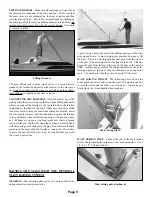
THE MOST IMPORTANT THING YOU MUST KNOW IS
THE DIRECTION FROM WHICH THE WIND IS BLOW-
ING.
Program someone to ask you, every 2 minutes “where is
the wind coming from?” You must point to it instantly, and be
right. Put a Windex wind vane at the top of the mast, and keep
your eye on it. If you don’t know wind direction, you will look
sort of stupid when trying to use the wind as your engine. There
are clues everywhere; flags, smoke, dust, moving clouds, ripples
on the water, other sailboats, and blowing debris. Above all, you
can feel the wind direction on your face. Turn toward the wind.
When you are aimed straight at it, you will feel it evenly on both
ears, cheeks, hair, etc. Be aware.
SAILING DOWNWIND
. Sailing with the wind is easy. Just aim
the boat and the wind will blow you along. A boat sailing down-
wind looks like this.
Sailing downwind
This is no more complex than letting a balloon blow with the
wind. (Except that you can steer.) You can sail downwind, slow-
ly, even without sails. (This is good for docking.)
Just get the sails out there at right angles to the wind. You control
the angle of the sails to the wind with the sheets (the lines that
connect to the rear of the jib and to the rear of the boom). The
wind pushes on the sails, and the boat moves. Notice the turbu-
lence behind the sails, just like the turbulence behind a truck as it
speeds along. If the wind gets on the wrong side of the mainsail,
it can slam over fast and hard, just like the wind will slam a door
if it gets on the wrong side. This is called jibing. Be careful.
More on this later.
SAILING ACROSS THE WIND.
This is a whole different act.
Notice, in the next set of drawings and photos, that the wind is
now flowing smoothly across the sails, much like the wind moves
across the wing of an airliner.
Sailing across the wind
Basically, the sails are diverting wind from its original direction
toward the rear of the boat. Every pound of wind that is deflect-
ed toward the rear of the boat gives a forward push to the boat.
Actually, the wind gives a push both forward and sideways (mak-
ing the boat lean). However, the rudder and the daggerboard keep
the boat from sliding sideways, so it squirts forward, much like a
watermelon seed shoots out forward when you squeeze it between
your fingers.
SAILING INTO THE WIND.
This is just like sailing across the
Page 22
HOW TO SAIL
Summary of Contents for 26 M
Page 28: ...Page 28...







































